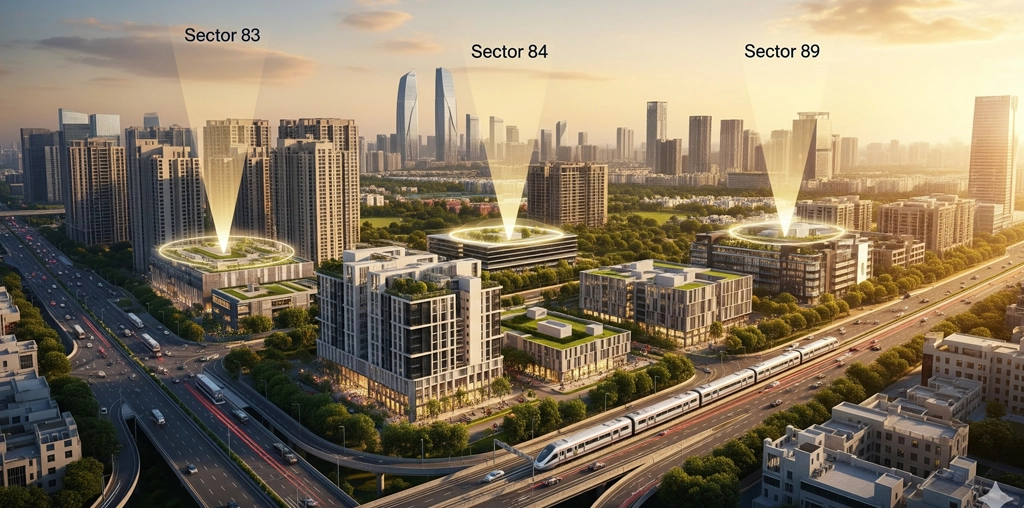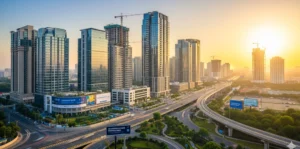
Introduction
The planned Multi-Utility Corridor (MUC) is a game-changer for New Gurugram. This 60-75 m wide corridor will run roughly north-south, linking the Dwarka Expressway area to the Gurugram-Manesar region via new and upgraded roads. In effect, it creates a direct high-capacity route between Delhi (through Dwarka Expressway) and Manesar (industrial belt southwest of Gurgaon). Traffic experts say this will decongest NH-48 and inner Gurugram roads, dramatically cutting travel times. For example, Sector 89 (parallel to Dwarka Exp) is already benefiting: “The presence of the Multi Utility Corridor (MUC) ensures quick access to neighboring business and residential districts, reducing travel time”. Instead of a winding ride on NH-8, commuters can zip through wide, grade-separated expressways.
Traffic Relief
By linking key highways (Dwarka Expressway, NH-48, Pataudi Road and peripheral roads), the MUC will divert long-distance traffic away from congested central routes. Once segments open – in some parts already under construction – a car could reach Manesar industrial areas from Delhi in ~30 minutes. Local media report on clearing encroachments and finishing service roads along this 5-6 km stretch (from Gurugram’s Elan Mall to Dadi Satti Chowk). GMDA has announced road-widening, new service roads, cycle tracks and sidewalks as part of this project. Planners say once fully ready, sectors 84-88 and 85-89 (east and west of the corridor) plus the new 86/90 and 87/91 arterial roads will knit Gurgaon closer together, making travel faster and safer.
Infrastructure Synergy
Beyond traffic, the MUC is designed as a utility corridor – space will be reserved for power lines, telecom, pipelines and even possible metro/rapid-rail lines as the city grows. Essentially, it serves as a backbone for multiple systems. This coordinated planning (roads + utilities) is a modern approach Gurgaon is adopting. Its existence on the masterplan has already spurred local development; developers and buyers often cite the corridor as a boon for future connectivity.
Real Estate Uplift
Wherever new highways or expressways have opened, property values have soared – and the MUC is no exception. A parallel example is the Dwarka Expressway: launch prices near it almost doubled from ~₹9,400/sqft in 2020 to ~₹18,700/sqft in 2024, making sectors along Dwarka (37D, 113, etc.) among Delhi-NCR’s hottest markets. By extending that network southwards, the MUC essentially pushes that growth wave into New Gurugram. Early signs are emerging: sectors abutting the MUC (e.g. 84-85 or 89-90) see brisk sales of newly launched flats and plots, partly on MUC-related hype. Industry insiders predict the corridor will transform “idle” or sparsely occupied land into valuable real-estate corridors. The Tribune even named Sector 89 the “hottest” area in Gurugram, explicitly noting that MUC-driven connectivity is fueling investor interest there.
Long-term Gains
Crucially, unlike short-lived booms, such infrastructure effects tend to last. Analysts highlight that as roads and utilities settle in, more amenities follow – schools, malls, business parks – creating full-fledged townships. For example, one developer notes that Dwarka Exp’s integration into the MUC will link Gurgaon all the way to Manesar’s industrial zone, “enriching the region’s connectivity”. Similarly, the new corridor is expected to attract mixed-use projects: residential towers, commercial offices and retail along its stretch, drawing both renters and businesses.
Conclusion
In sum, the Multi-Utility Corridor is poised to be much more than just a road. It will be a growth spine: relieving congestion today and laying groundwork for tomorrow’s townships. As one market report quips, areas near this corridor are set to turn into a “real estate goldmine” – the combination of major traffic relief and planned infrastructure generally translates into robust property demand. Early indicators (land prices rising in adjacent sectors, new project announcements) suggest that investors are already positioning themselves along this belt, anticipating the corridor’s completion.



